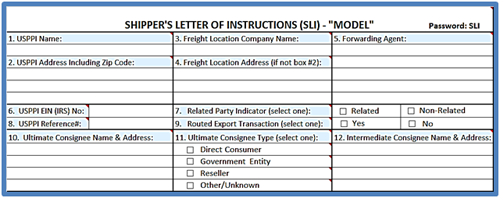 When it comes to preparing export paperwork, the Shipper’s Letter of Instruction (SLI) is one document that many exporters are inexplicably reluctant to prepare. They shouldn’t be.
When it comes to preparing export paperwork, the Shipper’s Letter of Instruction (SLI) is one document that many exporters are inexplicably reluctant to prepare. They shouldn’t be.
An SLI is one of the 11 most important export documents. It provides instructions to the freight forwarder about the shipment, and it often includes a limited Power of Attorney statement that gives the forwarder authority to sign documents—and perhaps submit the electronic export information (EEI) through the Automated Export System (AES)—on behalf of the exporter.
By completing an SLI and sending it to the freight forwarder, you are establishing a best practice for your firm. You have a written record of who received the shipping documents, who to contact for questions, who to contact for proof of export, and who issued the export control documentation that supports the decision to send your products to your foreign customer.
5 Reasons to Use a Shipper’s Letter of Instruction
While there are several reasons to create an SLI, here are the top five:
- The exporter, which is referred to as the U.S. Principal Party in Interest (USPPI) in the FTR, has a written record of its instructions to the forwarder.
- It acts as the request for documents prepared by the freight forwarder, including the relevant Electronic Export Information (EEI) extract, any other export control documents, and the international bill of lading.
- It provides the data elements that are required for filing the EEI as specified in the Foreign Trade Regulations (FTR).
- If you are authorized to provide the freight forwarder with a written power of attorney, it includes this provision for the USPPI along with a signature line.
- The format you use can be modified by you and your team to include additional data or instructions.
SLI in NCBFAA Format
The National Customs Brokers and Forwarders Association of America (NCBFAA) has developed a template for the SLI that most exporters will benefit from using. The NCBFAA has not only provided the form, they have prepared a set of instructions that references the regulations for each field that is available for completion. In addition, they have prepared a template for a power of attorney, a USPPI Information Sheet, and a combined bill of lading. All of these templates, forms and instructions are available to the public on their website.
Below is an extract from the NCBFAA SLI. Click on the image to download a PDF version of the form.
Stop Using the Shipper’s Export Declaration
Believe it or not, there are still some exporters who use the old Shipper’s Export Declaration (SED) as their SLI. The Foreign Trade Regulations retired the SED way back in 2014 when they replaced it with the EEI filing requirement through AESDirect. At the time, the U.S. Census Bureau claimed that more than half the paper SED filings contained errors.
If you use the SED as your SLI, not only are chances high that you have not completed it correctly, but it doesn’t include all the data fields forwarders need to submit the EEI filing. Without all the required information, forwarders must reach back out to you for the missing information, which may cause your shipment to be delayed.
By using the SLI in NCBFAA format, your firm will have a model that is easy to use, provides the necessary data to the freight forwarder or your internal team member who is completing the AES filing, and supports your firm’s export compliance efforts.
Now that I’ve (hopefully) convinced you to complete the SLI, here are 10 Steps for Correctly Completing a Shipper’s Letter of Instruction.
Like what you read? Subscribe today to the International Trade Blog to get the latest news and tips for exporters and importers delivered to your inbox.
This is an updated version of an article that was first written by Catherine J. Petersen and published in October 2014. It has been revised to includes current information, links and formatting.

